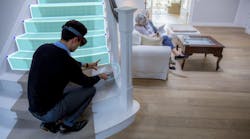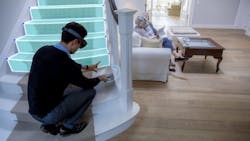Augmented reality and virtual reality hardware has been making headway in the engineering space. At Solidworks World 2017, several companies demonstrated how Solidworks can be used to simulate design concepts and provide a virtual collaborative space. Having tried many of these virtual reality (VR) headsets myself (HTC Vive, Oculus Rift, Playstation VR), I found limitations in each that would make it difficult for them to become an everyday engineering tool. However, with the mixed-reality concept of the Microsoft Hololens, there is the potential for it to become the next disruptive engineering tool.
The limitations I found with each of the VR headsets boiled down to three major points: the controls, the interaction with the user, and the interaction with its environment. My background is in computer-aided design and manufacturing (CAD/CAM), specifically Catia V5. Of course, no one starts off a genius in CAD/CAM. It takes time to master the controls and to learn all the menu functions, especially those operations hidden deep within the menu bars. But the difference is the interactive tool is well known: the computer.
Computers have been around for more than 20 years and the concept of using a mouse or trackpad/ball has become second nature. The controls in VR are motion-control sticks that track your movement and have buttons and joysticks located on them to operate menu items. Essentially they should operate just like a pick-and-point mouse, but they don’t. Due to the headset, you cannot see your hands and some virtual displays do not include a virtual model of your controllers, so you are operating them blindly. Of course, for experienced users this is nothing but a learning curve, but this hurdle stops it from becoming a collaborative tool. As a design engineer, you would not be able to have your supervisor wear the headset and check the virtual model if they themselves were not versed in the tool.
That leads to the next point, which is the interaction with the user. You are limited to what the controls can do. The model does not recognize you in the virtual space. The camera is meant to track your head movements but your hands are only tracked when holding the motion control. This takes the natural feeling of wanting to use your hands to manipulate the model. Lastly, the model interaction with the surrounding environment is very limited. If you had a component of a larger product modeled virtually, you would not be able to overlay it with the physical build in front of you. You would need to scan the physical world into your virtual world to see how the two would fit together.
Microsoft with the Hololens is introducing its concept of mixed reality. Mixed reality is a combination of augmented reality (AR) and virtual reality. As they define it, the Hololens has the capability to venture into both worlds of AR and VR. In the mixed-reality spectrum, the physical reality and digital reality are on opposite ends. As you enhance the physical space, you enter the AR world and as you enhance the digital space you enter the VR world. The goal for the Hololens is to live in the middle of this spectrum, combining the reality of holographic capabilities with reality immersive virtualization. Mixed reality requires perception and environmental awareness, which can be any combination of people, places, or things.
This is why the Hololens has the ability to exceed in areas where VR headsets have not. The ability to overlap CAD models with the real-world environment provides engineers interactive opportunities with their models. The Hololens is an untethered device that responds to hand gestures. According to Greg Sullivan, product engineer from Microsoft, Hololens is not just a wearable device but actually a Windows 10 computer.
At the Microsoft booth in Hannover Messe, they had a reality demo with ThyssenKrupp, an elevator company that specializes in in-home elevator installations. I was able to try on the Hololens and within a few minutes map out the path necessary for the elevator. The process was interactive by using a physical point indicator like a mouse that could be read by the headset. I could see and walk on the stairs by using the physical pointer, select my design points to create the elevator installation plan. The video from ThyssenKrupp illustrates the process.
The uses for the Hololens are growing. Schneider Electric is using the Hololens for the EcoStruxure for Industry Architecture, which will help customers increase the value of digital technologies. Dassault Systemes is also working with the Hololens to create mixed-reality views of their virtual manufacturing plants in real world environments. When speaking with Mike Felten, sales director for 3DExperience, the major hurdle will be in the translation software from CAD developers and Microsoft. The current process is too long and requires too much preparation to translate correctly. According to Felton, Dassault Systemes hopes that a model can instantaneously be created in their software and be exported directly to the Hololens without any need for conversion. That would be the next step necessary to make the Hololens a true engineering design tool.


